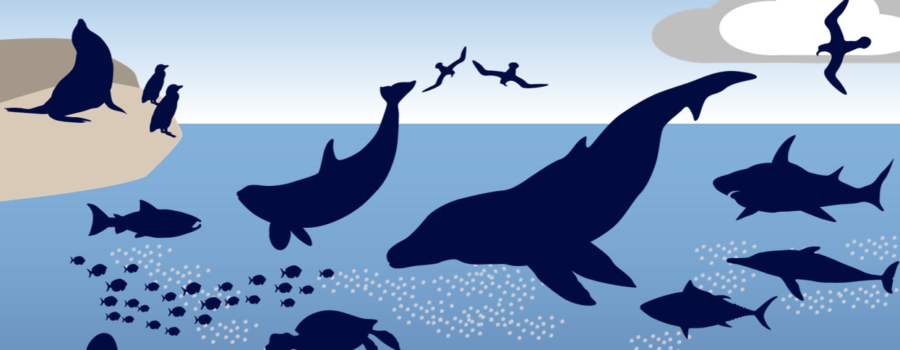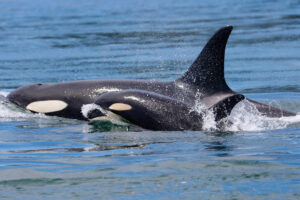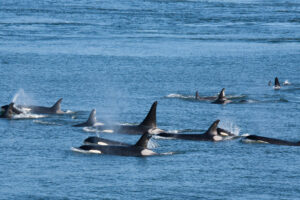With all the pressures we place on our ocean, do you ever wonder which one puts life below water at the most risk? When you look at the list, it’s clear that we humans are responsible for creating some massive problems. Each of them is a travesty. Taken together and left unchecked, they are a catastrophe in the making. But if you were to pick the worst of them, which would it be? And what can we do about it?
Man-made pressures on the ocean
I like to think of them in two categories – what we put into the ocean and what we take out of it:

It’s hard to identify the worst among so many bad actors. I’ve spoken to a number of professors and scientists who say they are most seriously concerned about the negative effects of acidification.
I can hear you questioning this. When I first heard this answer, I did too. After all, it is hard to miss the growing chorus of voices demanding attention to the seemingly never-ending flow of plastic pollution, or the abject horrors of overfishing, or the potential to restore habitats by removing unproductive dams. These drum beats would lead one to believe that those are the most serious problems we’ve created. They are indeed daunting, and we must address them, but one can argue that the most insidious problem the ocean has gets far less attention. Acidification.
What is ocean acidification?
Literally, acidification means to become more acidic or less alkaline. It does not mean that the ocean will become an acid. For those of us who have seen the original 1979 Alien movie, let me say “Whew”! The ocean will likely remain alkaline, but if we do not stop pumping carbon into the atmosphere, it will continue to become less alkaline, or more acidic over time.

“It’s a lot easier to say ‘ocean acidification’ than ‘ocean de-alkalinization,”
– Sarah Cooley, Woods Hole Oceanographic Institute1
Acidity and its opposite alkalinity are measured on the pH scale from 0-14. Pure water is neutral with a pH of 7. Solutions with a pH less than 7 are acidic; those with a pH greater than 7 are alkaline or basic.
The pH of ocean water varies from 7.5 to 8.5 depending on depth, season, and geographic location. In a healthy ocean, the average pH of surface water is about 8.22, a little more than 10 times more alkaline than pure water.
The average pH of today’s ocean surface water has decreased from 8.2 to 8.1.3 While that may seem like a small change, the pH scale is logarithmic so that 0.1 difference is actually about a 30% increase in acidity.4 By 2100, current climate change projections estimate the pH will drop further to 7.8.5
What is causing ocean acidification?
In short, we are. The ocean absorbs 30% of the carbon dioxide (CO2) in the atmosphere. As the amount of CO2 that we release into the atmosphere increases, the amount of CO2 the ocean absorbs increases too. The CO2 reacts with the seawater (H20) to create carbonic acid (H2CO3) which lowers the pH.
What does acidification do to life underwater?
By changing the chemistry of the seawater, acidification threatens to destabilize and unravel the food web. It is a direct threat to plankton, the foundational species of the food web, as well as many larger marine species. Because billions of people depend on the marine food web, it is a threat to us, too.
Plankton is marine life that drifts with the currents. There are two types – phytoplankton (tiny plants) and zooplankton (tiny animals).

Phytoplankton
Image Credit: NOAA
Zooplankton – an Amphipod
Image Credit: Jenn Willson, University of Washington
Phytoplankton
Microscopically small, phytoplankton are plants that use the sun’s energy, nutrients in the water, CO2, and photosynthesis to generate food and oxygen. Just as plants on land do. They serve as a primary food source for zooplankton and larger animals that filter the water such as corals and shellfish.
Acidification seems to affect various species of phytoplankton differently. The additional CO2 causes some species to grow faster and thrive, while other species seem to die off.6 Scientists are not yet certain how changes in these phytoplankton populations will affect the food web or the production of oxygen. Since 50%-80% of the world’s oxygen comes from phytoplankton7, this warrants more research.
Zooplankton
Zooplankton can be either be very tiny, fully-formed animals, such as the amphipod in the photo above, or it can be the drifting larvae spawned by larger animals, such as oysters, crab, and fish. Some portion of these larvae serve as food for other animals, but some must survive to propagate their own species.
In some cases, acidification interferes with a larval fish’s sense of smell, which prevents it from avoiding predators. In other cases, it interferes with the growth of shells and exoskeletons which rely on an abundance of calcium and carbonate in the seawater. Carbonic acid readily reacts with carbonate. It literally competes with animals for carbonate in the seawater. The more CO2 enters the ocean, the more carbonic acid is created and the more carbonate that acid attracts. The result is less carbonate available for larval animals such as clams, oysters, scallops, mussels, corals, sea stars, sea urchins to make shells. Without shells, they cannot survive to adulthood.

Equally alarming is the impact it has on other zooplankton species that form shells, such as pteropods, which are a primary food source for many fish and shrimp. Today, pteropod shells are being weakened by the increased acidity of the water.8 What will happen in the future? Scientists immersed pteropods in seawater with a pH of 7.8 – the projected pH of the ocean in 2100 – and found that their shells simply dissolved.9
By threatening plankton, acidification attacks a foundational food source for species throughout the food web. It also attacks the ability of shelled animals to reproduce. Since people rely on fish and shellfish for both food and income, acidification threatens us as well.

That is bad, but why is acidification the biggest threat?
To have a healthy ocean, we need to address all of its man-made threats. That said, acidification may do the most damage and is probably the hardest one for us to address. Why? First, it attacks the foundation of the food web. Second, it’s a slow process, less visibly dramatic, easier to overlook, and therefore harder to get people to focus on it. And finally, we have the ability to fix the other problems in the near term, IF we chose to do so, but we do not yet have the ability to stop emitting carbon into the atmosphere.
That’s a big if.
We can choose to do these things: stop dumping garbage into the environment; regulate and actually enforce sustainable fishing practices; stop deforestation; remove unproductive dams from our watersheds. Will any of that be painless? Of course not. It will be monumentally difficult and people will feel real pain from the changes. But if we had the will, we could choose to do those things tomorrow.
For acidification, even if we choose to, we can’t go cold turkey and stop emitting carbon tomorrow. The way we produce energy, make things, grow things and move around all emit carbon. We have to change the way we do those things, and that will take time.
From 51 billion to zero

In his new book, “How to Avoid a Climate Disaster: The Solutions We Have and the Breakthroughs We Need”, Bill Gates does a beautiful job simplifying the overall climate change problem and setting our objective: Reduce global carbon emissions from 51 billion tons per year to zero. He explains that getting there will require unprecedented international cooperation and technical innovations in energy, agriculture, manufacturing, and transportation that don’t exist yet.
Even if we all agree to execute Bill’s plan, it will take decades to reach zero. During that time, the ocean will continue to become less alkaline (more acidic), fundamentally unraveling the food web in ways we cannot yet imagine.
Bring on the spotlight
It’s not that no one is working to understand acidification or how to adapt to it. They are. The NOAA Ocean Acidification Program leads an international community to understand what is happening. The Seattle Times published an excellent, in-depth account of acidification’s threat back in 2014. Every ocean conservation organization has something to say on the topic.
The problem is that all the other issues get more of the spotlight. Images of plastic pollution, industrial fishing, dying salmon runs, and starving whales are far easier to rally around on social media. They are instantly understandable and elicit powerful emotional responses. Acidification doesn’t get the limelight. It doesn’t feel immediate. It is harder to capture in a photograph. The call to action is far more difficult.
If we fail to pay enough attention to acidification, we will fight all of those other fights and still lose the war.
What can we do?
Get to zero as quickly as we can. It’s a heavy lift. This is not something we as individuals can do on our own. We need to demand that governments at the national, state, provincial, and local levels harness our economies to do it. They need to invest in innovation and establish incentives that accelerate behaviors that get us to zero. We as individual consumers need to help by showing demand for the solutions that innovators bring to market.
In Chapter 12 of his book, Bill recommends the following10:
As a citizen
- Make calls, write letters, attend town halls
- Engage local governments as well as national ones
- Run for office
As a consumer
- Sign up for a green pricing program with your electric utility, such as PSE’s Green Power Program
- Reduce your home’s emissions. See NPR’s Taking Care of Climate Change at Home
- Buy an electric vehicle. See Ten Questions to Ask Before You Buy and EV
- Try a plant-based burger
As an employer
- Set up a carbon tax within your company
- Prioritize innovation and low carbon solutions
- Be an early adopter of new, green technologies
- Engage in the policy-making process
- Connect with government-funded research
- Help early-stage innovators succeed
Go Deeper!
Go Deeper to explore the ocean and the Salish Sea through a curated list of articles, books, films, and other resources.
To learn more about the topic in this article, check out the following resources:
- NOAA. Ocean Acidification Program (OAP)
- The Seattle Times. Sea Change: Ocean Acidification
- The SeaDoc Society. Ocean Acidification & the Health of the Salish Sea
- Bill Gates. How to Avoid a Climate Disaster: The Solutions We Have and the Breakthroughs We Need
Acknowledgments
- Thanks to Molly Allen and Rod Willson for reviewing and improving this article.
End Notes
1Winner, Cherie. “Small Drop in PH Means Big Change in Acidity.” Oceanus, Woods Hole Oceanographic Institution, 20 Jan. 2010, www.whoi.edu/oceanus/feature/small-drop-in-ph-means-big-change-in-acidity/.
2Investigating Oceanography, by Keith A. Sverdrup and Raphael Kudela, McGraw-Hill Education, 2020, p. 144.
3Chu, Jennifer. “Ocean Acidification May Cause Dramatic Changes to Phytoplankton.” MIT News, Massachusetts Institute of Technology, 20 July 2015, news.mit.edu/2015/ocean-acidification-phytoplankton-0720.
4Winner, Cherie. “Small Drop in PH Means Big Change in Acidity.” Oceanus, Woods Hole Oceanographic Institution, 20 Jan. 2010, www.whoi.edu/oceanus/feature/small-drop-in-ph-means-big-change-in-acidity/.
5-6Chu, Jennifer. “Ocean Acidification May Cause Dramatic Changes to Phytoplankton.” MIT News, Massachusetts Institute of Technology, 20 July 2015, news.mit.edu/2015/ocean-acidification-phytoplankton-0720.
7“How Much Oxygen Comes from the Ocean?” NOAA’s National Ocean Service, NOAA / U.S. Department of Commerce, oceanservice.noaa.gov/facts/ocean-oxygen.html.
8Welch, Craig. “Acidification Eating Away at Tiny Sea Snails | Sea Change.” The Seattle Times, The Seattle Times Company, 2014, apps.seattletimes.com/reports/sea-change/2014/apr/30/pteropod-shells-dissolving/.
9What Is Ocean Acidification?, NOAA PMEL Carbon Program, www.pmel.noaa.gov/co2/story/What+is+Ocean+Acidification%3F.
10How to Avoid a Climate Disaster the Solutions We Have and the Breakthroughs We Need, by Bill Gates, Allen Lane, an Imprint of Penguin Books, 2021, pp. 218–226.





Leave a Reply
Your comments are welcome.